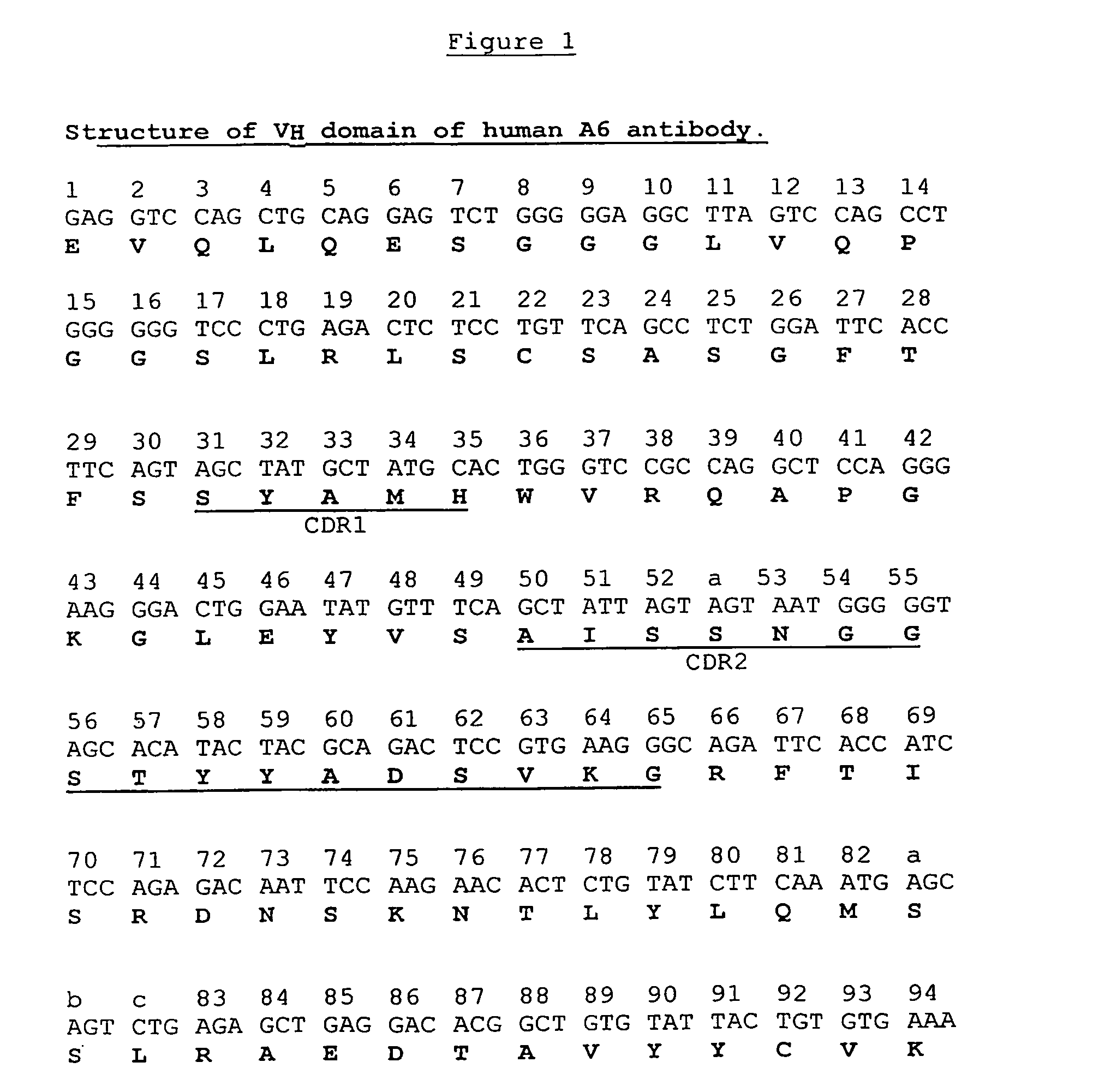Phage display libraries of human VH fragments
a technology of human vh fragments and display libraries, which is applied in the field of combinatorial libraries including phage display libraries, can solve the problems of questioned whether single-domain antibodies with desired affinities can be generated with such configurations, and achieve useful solubility properties and increase solubility properties
- Summary
- Abstract
- Description
- Claims
- Application Information
AI Technical Summary
Benefits of technology
Problems solved by technology
Method used
Image
Examples
example 1
[0119]A dAb phage display library was constructed employing the VH portion of A6 as a starting template and amino acid substitutions at positions 6, 23, 82a, 93 and 108, as shown in Table 5 below. In addition, silent mutations were introduced in codons for amino acids 3-16 (FR1) to remove a putative recombination site. All mutations were introduced by splice overlap extension—PCR(SOE). The modified VH was used as a scaffold for complete randomization at positions 100i-100n located at the carboxy terminal of the CDR3 of A6.
[0120]
TABLE 5A6VH-L1 TemplatePosition and Amino Acid IdentityPosition62382a93108Wild Type A6VHESSVTModified A6VHAANAQ
Removal of Putative Recombination Site
[0121]The codons for amino acids 3-16, which surround the recombination site, were changed. Using the Chi.R / FP and Chi.F / RP primer pairs (Table 6) and pSJF-A6VH plasmid as template, 5′ and 3′ fragments were synthesized by PCR in a total volume of 50 μl containing 10 pmol of each primer, 2 mM of each of the four d...
example 2
[0128]A library (A6VH-L1a) in which residues 100i and 100n were deleted and residues 95-100h were randomized with 50% biasing in favour of the parental amino acid constitution, was also constructed. The procedure for A6VH-L1 a construction was identical to that for A6VH-L1 except that the randomization primer used in the first PCR step was A6VH.95-100hRndm CCCTTGGCCCCAGATATCAAA14[(A / C)NN]TTTCGCACAGTAATACAC. The sequence of the A6VH for this library is shown in FIG. 12.
example 3
[0129]A6VH-L2, a parental VH ligand binding molecule in which each of positions 6, 23, 74, 82a, 83, 84, 93 and 108 were modified as shown in FIG. 3 relative to the native A6VH(FIG. 1), was also constructed. Mutations at positions 74, 83 and 84 were introduced with a single mutagenic primer, A6VH.S74A.F, (5′CATTTGAAG-ATACAGAGTGTTCTTGGCATTGTCTCT3′), which when used together with RP (see Example 1 above) generated an N-terminal fragment. A second primer, A6VH.R83K / A84P.R., (5′TATCTTCAAATGAACAGTCTGAAAC-CAGAGGACACGGCT3′), together with FP (see Example 1 above) generated a C-terminal fragment. The two fragments were joined by SOE, using RP and FP as primers, to give the gene encoding A6VH-L2. This molecule showed slightly better levels of monomer production when expressed and assessed by size exclusion chromatography when compared with A6VH-L1.
[0130]
TABLE 7Amino acid identity at positions 6, 23, 74, 82a, 83, 84, 93 and 108for A6VH and the mutants of A6VH.3Amino acid IdentityKabat #6237482...
PUM
| Property | Measurement | Unit |
|---|---|---|
| dissociation constants | aaaaa | aaaaa |
| volume | aaaaa | aaaaa |
| pH | aaaaa | aaaaa |
Abstract
Description
Claims
Application Information
 Login to View More
Login to View More - R&D
- Intellectual Property
- Life Sciences
- Materials
- Tech Scout
- Unparalleled Data Quality
- Higher Quality Content
- 60% Fewer Hallucinations
Browse by: Latest US Patents, China's latest patents, Technical Efficacy Thesaurus, Application Domain, Technology Topic, Popular Technical Reports.
© 2025 PatSnap. All rights reserved.Legal|Privacy policy|Modern Slavery Act Transparency Statement|Sitemap|About US| Contact US: help@patsnap.com



